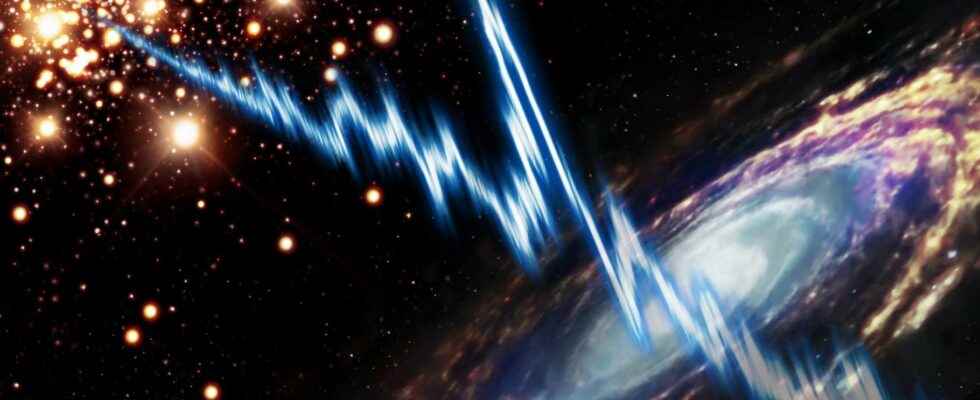You will also be interested
[EN VIDÉO] Gamma-ray bursts: neutron star collisions light up the Universe Gamma-ray bursts are the brightest events in the Universe in the field of electromagnetic waves. We can observe one per day on average on the celestial vault and they occur in distant galaxies. There are two types, short and long. This video explains the nature of short bursts.
Those that the astronomers now know as fast radio bursts — FRB for Fast Radio Bursts –, those are flashes of extremely short radio waves — of the order of a thousandth of a second –, but also very energetic — they emit more than the Sun in an entire day — appearing in the sky in totally unpredictable ways. Since their discovery in 2007, astronomers have managed to locate the source of around twenty of them. In amazingly diverse galaxies. And they had ended up thinking that these FRBs were the fact of magnetarsa particular type ofneutron stars to magnetic field extremely intense.
But in January 2020, an international team recorded a signal unlike any other in the heart of the Big bear. Code name: 20200120E. A few months later, using the twelve radio telescopes of the European network ofinterferometry very long base (VLBI), astronomers were able to study in detail five of these somewhat unusual fast radio bursts.
A signal qualified as special because astronomers traced its trace and located its origin in the periphery of the spiral galaxy M81. A galaxy positioned just 12 million light-years from Milky Way. Enough to make 20200120E the extragalactic FRB — because, in 2020, an FRB had been identified in our Galaxy — the closest ever detected. But that’s not all. Because researchers even claim that we sometimes have one of the big globular clusters of M81. In other words, from a region populated by old stars.
Yet, until then, fast radio bursts had only been found in parts of theUniverse populated by much younger stars. The magnetars indeed correspond a priori to what remains of short-lived massive stars duration of life. And the researchers imagine that after 10,000 years, the cores of magnetars are no longer sufficiently energetic to produce fast radio bursts. So the globular clusters should not be able to contain FRB-causing magnetars.
A type of magnetar never observed before?
But astronomers still have an explanation for their latest sighting. They are a reminder that double stars are numerous in star clusters. Some are so close that one of the stars in the system can suck the matter the other. These cannibalistic stars end their lives as neutron stars. In a type predicted by models, but never yet observed, of magnetar formed by thecollapse of one white dwarf under its own weight. An accretion-induced collapse, say the astrophysicists. The event is rare but it appears to be the simplest way to produce FRBs within a globular cluster.
The researchers were also surprised by the brevity of certain flashes which did not last more than a few tens of nanoseconds. They conclude that their source is very small. Potentially only a few tens of meters in diameter.
What the brevity of these signals also reminds astronomers is the behavior of the pulsar — another type of neutron star — called the Crab. The remnant of a star’s explosion in supernova in the region of the Taurus Constellation. “All of this suggests that FRB 20200120E does indeed come to us from a magnetar, but from a place where magnetars shouldn’t exist.”comments Kenzie Nimmo, researcher at the University of Amsterdam (Netherlands) in a press release from the Max-Planck Institute (Germany).
To confirm their hypotheses — or move towards another thesis such as that of an unusual pulsar or a black hole in orbit close around a massive star — astronomers will need to collect some additional data on 20200120E. And these observations could teach them new things about the life cycle of stars in our Universe.
Support your independent scientific media: discover our subscription formulas!
4 good reasons to subscribe to Futura on Patreon:
- A site without any advertising from 3.29 euros per month.
- It is without commitment.
- Access to priority content, in preview, just for you.
- You support our business in the best possible way. A real motivation for us!
Interested in what you just read?
